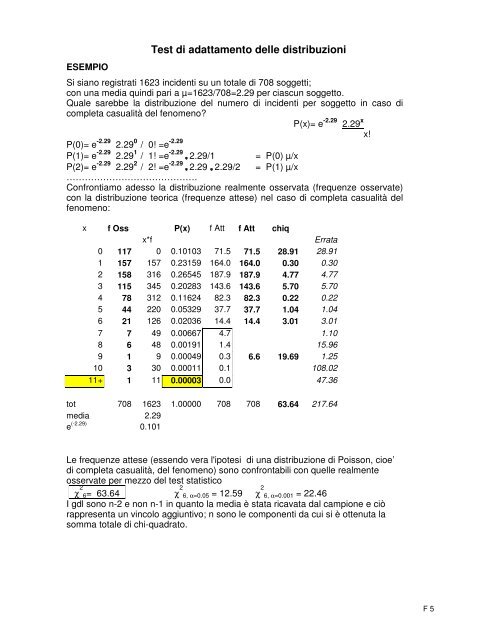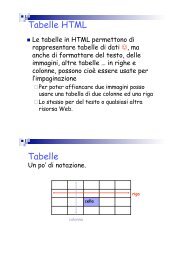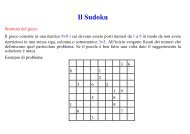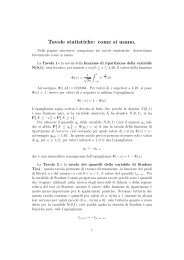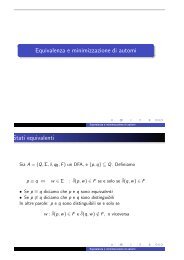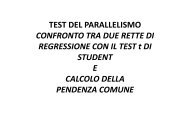Test per il confronto di 2 proporzioni , Analisi di dati qualitativi ...
Test per il confronto di 2 proporzioni , Analisi di dati qualitativi ...
Test per il confronto di 2 proporzioni , Analisi di dati qualitativi ...
You also want an ePaper? Increase the reach of your titles
YUMPU automatically turns print PDFs into web optimized ePapers that Google loves.
ESEMPIO<strong>Test</strong> <strong>di</strong> adattamento delle <strong>di</strong>stribuzioniSi siano registrati 1623 incidenti su un totale <strong>di</strong> 708 soggetti;con una me<strong>di</strong>a quin<strong>di</strong> pari a µ=1623/708=2.29 <strong>per</strong> ciascun soggetto.Quale sarebbe la <strong>di</strong>stribuzione del numero <strong>di</strong> incidenti <strong>per</strong> soggetto in caso <strong>di</strong>completa casualità del fenomeno?P(x)= e -2.29 2.29 xx!P(0)= e -2.29 2.29 0 / 0! =e -2.29P(1)= e -2.29 2.29 1 / 1! =e -2.29 ∗ 2.29/1 = P(0) µ/xP(2)= e -2.29 2.29 2 / 2! =e -2.29 ∗ 2.29 ∗ 2.29/2 = P(1) µ/x…………………………………….Confrontiamo adesso la <strong>di</strong>stribuzione realmente osservata (frequenze osservate)con la <strong>di</strong>stribuzione teorica (frequenze attese) nel caso <strong>di</strong> completa casualità delfenomeno:x f Oss P(x) f Att f Att chiqx*fErrata0 117 0 0.10103 71.5 71.5 28.91 28.911 157 157 0.23159 164.0 164.0 0.30 0.302 158 316 0.26545 187.9 187.9 4.77 4.773 115 345 0.20283 143.6 143.6 5.70 5.704 78 312 0.11624 82.3 82.3 0.22 0.225 44 220 0.05329 37.7 37.7 1.04 1.046 21 126 0.02036 14.4 14.4 3.01 3.017 7 49 0.00667 4.7 1.108 6 48 0.00191 1.4 15.969 1 9 0.00049 0.3 6.6 19.69 1.2510 3 30 0.00011 0.1 108.0211+ 1 11 0.00003 0.0 47.36tot 708 1623 1.00000 708 708 63.64 217.64me<strong>di</strong>a 2.29e (-2.29) 0.101Le frequenze attese (essendo vera l'ipotesi <strong>di</strong> una <strong>di</strong>stribuzione <strong>di</strong> Poisson, cioe’<strong>di</strong> completa casualità, del fenomeno) sono confrontab<strong>il</strong>i con quelle realmenteosservate <strong>per</strong> mezzo del test statisticoχ 2 6= 63.64 χ 2 6, α=0.05 = 12.59 χ 2 6, α=0.001 = 22.46I gdl sono n-2 e non n-1 in quanto la me<strong>di</strong>a è stata ricavata dal campione e ciòrappresenta un vincolo aggiuntivo; n sono le componenti da cui si è ottenuta lasomma totale <strong>di</strong> chi-quadrato.F 5


